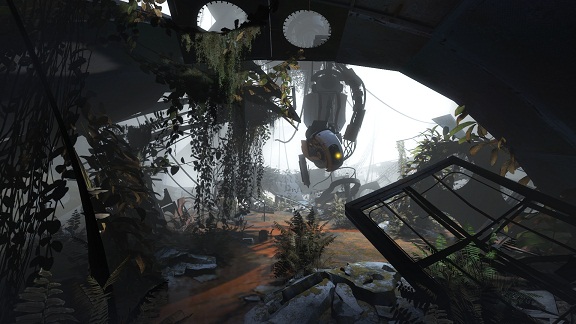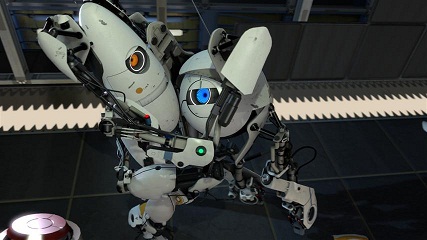Valve’s Portal was a game that broke the rules. A first-person shooter without shooting? This was a game that forced you to consider the environment your challenge, providing you with nothing but a tool to connect two spatial points and an impetus to use your brain to defeat said challenge. Of course, the mind constructing these puzzles for you added a great deal to the mythos and prestige of the title, as GLaDOS kept the player sharply enmeshed with both dark humor and malevolence. The popularity of the game was not in doubt, as merchandise was created to capitalize on the characters and even inanimate objects; the game itself was shipped to consoles as a package with other valve titles in the Orange Box. Truly, the cake was not a lie. And now, to the happiness of gamers everywhere, Portal 2 has been announced (as a full-length game, no less).
 After hundreds of years, the Aperture Science facility has become a shadow of the pristine and antiseptic environment it was in Portal. Decay and disorder have become the dominant theme of the labs, although parts of the facility remain operational. It is these elements which awake your protagonist, Chell, from stasis (a plot change to the original added shortly before Portal 2’s announcement) and requests that your assistance is required to repair the damage. Unfortunately, these efforts culminate in the revival of GLaDOS, who decides to restore the facility to its former glory and return Chell to her previous place as guinea pig for more ‘tests’.
After hundreds of years, the Aperture Science facility has become a shadow of the pristine and antiseptic environment it was in Portal. Decay and disorder have become the dominant theme of the labs, although parts of the facility remain operational. It is these elements which awake your protagonist, Chell, from stasis (a plot change to the original added shortly before Portal 2’s announcement) and requests that your assistance is required to repair the damage. Unfortunately, these efforts culminate in the revival of GLaDOS, who decides to restore the facility to its former glory and return Chell to her previous place as guinea pig for more ‘tests’.
As players will find out, these tests consist of once again using the Portal Gun to experiment and solve puzzles, however there are new gameplay mechanics that have been included to expand upon the breadth and variety of these puzzles. Valve managed to continue the practice of adapting amateur efforts to provide the engine of innovation for their new IP’s; as Portal was adapted from Narbacular Drop, a student project from Digipen. Portal 2 includes ‘gels’ which are applied like a liquid to surfaces that impart gravity effects, such as repulsion and attraction; these new effects were adapted from another Digipen team’s game that won the 2009 Independent Games Festival Student Competition prize, Tag: The Power of Paint. As in the previous game, “Checklisting” chambers provide safe practice areas to make sure players learn and relearn old and new techniques, while later areas provide for the combination and implementation of these techniques to navigate the facility.
Following the suggestions of fans, Valve has included a cooperative mode, in which two players (and four portals) combine and rely on each other to complete puzzles impossible to complete alone. This is a separate plot in which players take the roles of a personality core and a turret, each outfitted with arms, legs, and portal guns; GLaDOS actively attempts to split the two and the trust they must have in order to proceed.
The unique and likeable personality of the characters in the original Portal was one of the major attractors to the game, even down to the mewling of the sentry guns and the ascribed traits of an otherwise undistinguishable Companion Cube. Who didn’t feel like they had betrayed a good friend when they threw the Cube to its death in record time? And who didn’t feel something when they heard “Still Alive?” Recognizing that these relatable characters were integral requisites to its success, Portal 2’s plot has independent personality cores that interact with Chell throughout the game, each with their own voice actors, to allow greater freedom in the story than the original, while maintaining the place of GLaDOS as the primary motivator and villain.
Portal 2 is hotly anticipated as a powerful and effective continuation to the consistently good Valve roster of games. Portal 2 has been given a release date of February 9th, 2011.